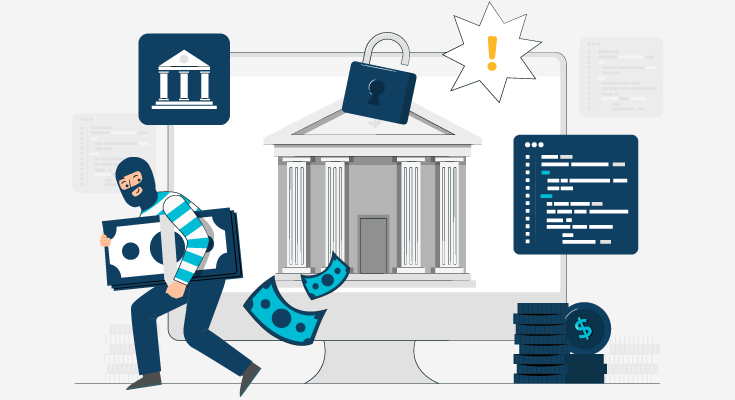As time spent online is growing at an exponential rate, the demand for digital services and solutions is at an all-time high. This demand for online services includes the banking sector as well. In the last few years, digital banking or online banking systems have grown rapidly and offer better and more effective solutions than traditional financial institutions.
Switching to digital solutions instead of physical methods of banking can prove to be incredibly convenient as customers can access all banking services 24/7 right from their phones or computers. Digital banking payment systems can reach more people across the globe in comparison to physical banking. With this sudden growth of options and banking, digital banking payment systems have become globally accepted, but one major factor remains, which is “Building trust”.
In this era of technological advancement, digital banking fraud is also growing. How can banks and other financial institutions save themselves from digital banking fraud?
Digital Banking vs Online Banking
Most users think that digital banking and online banking are the same things. The debate of digital banking vs online banking has been going on for a long time.
Digital banking is a solution where all the aspects of financial-related services are done through digital channels instead of visiting a physical bank. Online banking on the other hand offers only the core features of banking through an app or a website.
Digital banking digitizes every activity of the bank undertaken by the customers. Digital banking represents all the activities that can be done through a physical branch, and it offers even more features.
Challenger Banks vs Neobanks
A challenger bank has both the physical presence of a bank and it also offers complete digital banking solutions. Challenger banks offer both digital banking payment systems and traditional payment methods. Their footprint is significantly smaller in comparison to more widely known traditional banks.
Neobanks on the other hand, offer a wide range of financial and banking services completely through digital channels. Neobanks are basically a type of FinTechs that operates under a banking license that they either acquired as an independent entity or rented from a bank.
Both Challenger banks and Neobanks focus on improving customer experience and transparency. Their main goal is to offer brilliant services to compete with traditional banks that have a bigger footprint. Knowing their customers and building trust in digital payment systems from the moment of onboarding till their entire lifecycle is a crucial strategy for these types of FinTechs.
Both of them offer smooth and complete digital account opening facilities. They also keep adopting new technologies to prevent digital banking fraud.
Open Banking Systems
Open banking systems work in favor of customers’ demand for more choices, improved customer experience, and more control over their personal information. This is the system where customers are allowed to access and control their banking or financial accounts through third-party apps.
It prevents digital banking fraud by offering third-party financial services to open accounts, make transactions, and use any other financial data from banks and non-banks with the help of APIs. All of this control helps consumers access products and services across different institutions. These types of banks offer trust in digital banking systems as they employ the best security of technology to prevent digital banking fraud.
Use of Technology To Build Trust In Digital Banking System
A huge percentage of consumers feel that open banking will have a huge impact on how the banking industry works globally. According to several reports and surveys, it is expected that the open banking industry will have a revenue of £7.2bn.
It is expected that Neobanks and others can help in improving the banking industry to a more secure solution. One of the primary reasons these types of banks rely on technology so much is that they lack the resources to compete with traditional banks that have hundreds of thousands of physical branches. As they lack infrastructure, they rely on technology for complete automation of their banking operations, these operations can range from account opening to customer support.
All banks must keep up to date with digital fraud prevention and adopt newer technologies that can help you with digital fraud prevention. If the banks can utilize the right kind of onboarding technologies to reduce friction and improve the efficiency of the whole process with minimal error. Using this, banks can have a strong advantage over their competitors that are still going through the digital transformation process.
To build trust in the digital banking system, these are the most important questions a bank needs to ask:
- Is this a real person?
- Is this person who they claim to be?
- Can I do business with this person?
- Should I do business with this person?
Complete security and a satisfactory customer experience are vital components for success in the banking sector. Customers have to be able to trust that their personal and financial data is protected by the bank. And the banks who are looking forward to complying with industry regulations and AML practices, need to make sure that the customers are worth trusting from onboarding till the end of the relationship.
If a bank doesn’t have the proper technology, then fraudsters who know their way around technology can manipulate documents and cause millions of dollars worth of losses. FinTechs that make use of identity proofing and AML, KYC, document verification, and biometrics as part of their onboarding process will have a better chance at digital fraud prevention.
Integrated Method to Fight Digital Fraud
It is known that the best way to detect fraud, control, and fight financial crime is during the customer onboarding process. Low-friction KYC technology is important to make sure that the customers won’t abandon the process.
Despite knowing this, many digital onboarding processes continue to be static and only used during customer acquisition which leaves a lot of room for error. They don’t make use of machine learning and advanced algorithms to identify if a user can be trusted or not and prevent fraud.
How Does DIRO’s Technology Tackle The Problem?
Trust in the digital banking system is a tricky thing to establish, that’s where DIRO’s award-winning technology comes in. DIRO helps in making the onboarding process faster than ever by using brilliant document verification technology.
Banks or Financial institutions can make use of the technology to verify if the customer is real or not. This minimizes the risk for fraud prevention, as DIRO document verification can help in following KYC and AML compliance with ease.
The technology offered by DIRO can be used by all kinds of banks, financial institutions, and FinTechs to verify documents in a secure environment. You can easily verify bank statements, address proof, and utility bills. To improve trust in the digital banking system, banks need to utilize this technology.







